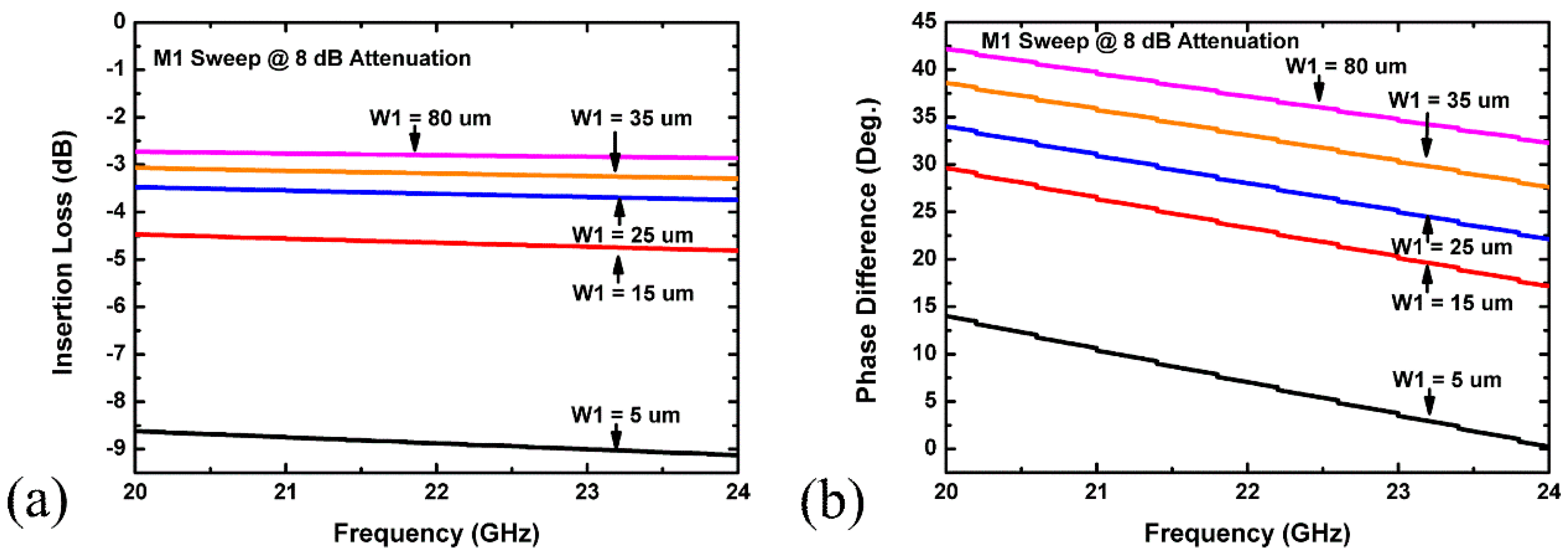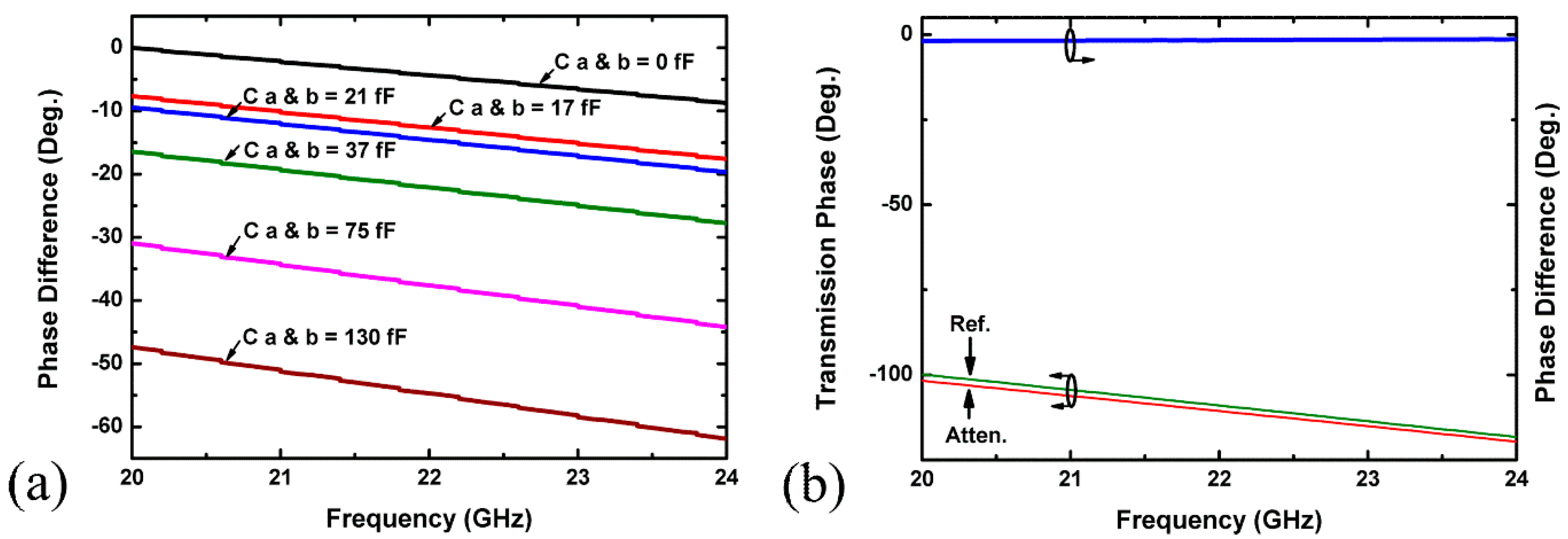A 6-Bit 0.13 μm SiGe BiCMOS Digital Step Attenuator with Low Phase Variation for K-Band Applications
Abstract
:1. Introduction
2. Design of the Attenuator
2.1. NMOS Switch
2.2. Conventional Attenuator Design
2.3. Proposed an Attenuator Design
3. Measured Results
- Process variations can cause a phase difference between the measured and simulated results because each process has its own resistance and capacitance variations up to the order of ±10%. Therefore, a cumulative effect of the process variation results in the form of overall capacitance of the system, which leads to a large phase error. The capacitance effect on the phase is also illustrated in Figure 6a,b.
- As mentioned in Section 2.3, the optimum component values of the capacitive phase correction network are very important to get the minimum phase error. Therefore, a minor contribution of parasitics (due to the testing hardware, external environment, etc.) can cause significant deviation from the targeted results and consequently, it appears in the form of large phase error.
4. Comparison with Other Technology Attenuators
5. Conclusions
Author Contributions
Acknowledgments
Conflicts of Interest
References
- Ellinger, F.; Vogt, R.; Bachtold, W. Calibratable adaptive antenna combiner at 5.2 GHz with high yield for laptop interface card. IEEE Trans. Microw. Theory Tech. 2000, 48, 2714–2720. [Google Scholar] [CrossRef]
- Dogan, H.; Meyer, R.G. Intermodulation distortion in CMOS attenuators and switches. IEEE J. Solid State Circuits 2007, 42, 529–539. [Google Scholar] [CrossRef]
- Ku, B.H.; Hong, S. 6-bit CMOS digital attenuators with low phase variations for X-band phased-array systems. IEEE Trans. Microw. Theory Tech. 2010, 58, 1651–1663. [Google Scholar] [CrossRef]
- Sun, P. Analysis of phase variation of CMOS digital attenuator. Electron. Lett. 2014, 50, 1912–1914. [Google Scholar] [CrossRef]
- Zhang, H.; Wan, C.; Zhu, D. In A high linearity digital attenuator with low phase variations for x-band phased array systems. In Proceedings of the 2016 IEEE International Conference on Microwave and Millimeter Wave Technology (ICMMT), Beijing, China, 5–8 June 2016; pp. 173–175. [Google Scholar]
- Ciccognani, W.; Giannini, F.; Limiti, E.; Longhi, P.E. Compensating digital attenuator differential phase shift. In Proceedings of the 2008 14th Conference on Microwave Techniques, Prague, Czech Republic, 23–24 April 2008; pp. 1–4. [Google Scholar]
- Ciccognani, W.; Giannini, F.; Limiti, E.; Longhi, P.E. Compensating for parasitic phase shift in microwave digitally controlled attenuators. Electron. Lett. 2008, 44, 743–744. [Google Scholar] [CrossRef]
- Dogan, H.; Meyer, R.G.; Niknejad, A.M. Analysis and design of RF CMOS attenuators. IEEE J. Solid State Circuits 2008, 43, 2269–2283. [Google Scholar] [CrossRef]
- Kaunisto, R.; Korpi, P.; Kiraly, J.; Halonen, K. In A linear-control wide-band CMOS attenuator, ISCAS 2001. In Proceedings of the 2001 IEEE International Symposium on Circuits and Systems (Cat. No.01CH37196), Sydney, Australia, 6–9 May 2001; Volume 454, pp. 458–461. [Google Scholar]
- Bae, J.; Lee, J.; Nguyen, C. A 10-67GHz CMOS dual-function switching attenuator with improved flatness and large attenuation range. IEEE Trans. Microw. Theory Tech. 2013, 61, 4118–4129. [Google Scholar] [CrossRef]
- Sjogren, L.; Ingram, D.; Biedenbender, M.; Lai, R.; Allen, B.; Hubbard, K. A low phase-error 44-GHz HEMT attenuator. IEEE Microw. Guided Wave Lett. 1998, 8, 194–195. [Google Scholar] [CrossRef]
- Inkwon, J.; Youn-Sub, N.; In-Bok, Y. In Ultra broadband dc to 40 GHz 5-bit pHEMT MMIC digital attenuator. In Proceedings of the 2005 European Microwave Conference, Paris, France, 4–6 October 2005. [Google Scholar]
- Hunton, J.K.; Ryals, A.G. Microwave variable attenuators and modulators using pin diodes. IRE Trans. Microw. Theory Tech. 1962, 10, 262–273. [Google Scholar] [CrossRef]
- Min, B.W.; Rebeiz, G.M. A 10–50 GHz CMOS distributed step attenuator with low loss and low phase imbalance. IEEE J. Solid State Circuits 2007, 42, 2547–2554. [Google Scholar] [CrossRef]
- Razavi, B.; Behzad, R. RF Microelectronics, 2nd ed.; Prentice Hall: Upper Saddle River, NJ, USA, 1998; ISBN 978-0-13-713473-1. [Google Scholar]
- Meyer, R.G.; Mack, W.D. A wideband low-noise variable-gain BiCMOS transimpedance amplifier. IEEE J. Solid State Circuits 1994, 29, 701–706. [Google Scholar] [CrossRef]
- Zhang, Y.; Zhuang, Y.; Li, Z.; Ren, X.; Wang, B.; Jing, K.; Qi, Z. A 5-bit lumped 0.18-μm CMOS step attenuator with low insertion loss and low phase distortion in 3–22GHz applications. Microelectron. J. 2014, 45, 468–476. [Google Scholar] [CrossRef]
- Sarfraz, M.M.; Liu, Y.; Ullah, F.; Wang, M.; Zhang, H. 4-Bit Ka band SiGe BiCMOS digital step attenuator. PIER Prog. Electromagn. Res. C 2017, 74, 31–40. [Google Scholar] [CrossRef]
- Bae, J.; Nguyen, C. A novel concurrent 22–29/57–64-ghz dual-band CMOS step attenuator with low phase variations. IEEE Trans. Microw. Theory Tech. 2016, 64, 1867–1875. [Google Scholar] [CrossRef]















| Atten. (dB) | Topology | R1 = R2 (Ω) | RP (Ω) | W1 (μm) | W2 (μm) | Ca = Cb (F) |
|---|---|---|---|---|---|---|
| 0.5 | Bridge-T | 3 | 211 | 10 | 20 | 17 |
| 1 | Bridge-T | 6 | 134 | 10 | 20 | 17 |
| 2 | Bridge-T | 10 | 236 | 65 | 20 | 17 |
| 4 | Bridge-T | 34 | 78 | 60 | 15 | 70 |
| 8 | π-Type | 60 | 124 | 25 | 15 | 37 |
| 16 | π-Type | 47 | 29 | 15 | 20 | 29 |
| References | [6] | [8] | [9] | [12] | [17] | [18] | [19] | This Work |
|---|---|---|---|---|---|---|---|---|
| Frequency (GHz) | 8–15 | 0.1–20 | Dc-18 | Dc-20 | 3–22 | 31–33 | 22–29 | 20–24 GHz |
| Attenuation Range (dB) | 23.5 (6-Bit) (LSB = 0.5 dB) | 23 (5-Bit) (LSB = 0.5 dB) | 27.9 (5-Bit) (LSB = 0.9 dB | 23.5 (5-Bit) (LSB = 0.5 dB | 31 (5-Bit) (LSB = 1 dB) | 16 (4-Bit) (LSB = 0.5 dB) | 16 (4-Bit) (LSB = 1 dB) | 31.5 (6-Bit) (LSB = 0.5 dB |
| Insertion Loss (dB) | <4.5 | 3–5 | 3–7 | <5 | 5.53–13.7 | <19 | 5.4–7.9 | 20.9–21.95 |
| Return Loss (dB) | >8 | >15 | >17 | >13 | >11 | >12.7 | N/A | >9 |
| RMS Attenuation Error (dB) | <0.45 | <1 | <0.5 | <0.5 | <0.53 | <0.8 | <0.51 | <0.43 |
| RMS Phase Error (Degree°) | N/A | 0.1–20 | 0–18 | N/A | 6.3 | 2.8–5.8 | 1–4.7 | 1.6–4.2 |
| Input P1dB (dBm) | N/A | 26 | 24 | 24 | 18.4 | N/A | 14 | 14 |
| Structure | Switched π/T | N/A | Switched T | Switched T | Switched π/T | Switched T | Switched π/T | Switched π/T Bridge |
| Technology | GaAs | GaAs | GaAs | GaAs | 0.18 µm CMOS | 0.13 µm SiGe BiCMOS | 0.18 µm CMOS | 0.13 µm SiGe BiCMOS |
| Size (mm2) | 3 × 2 | 2.34 × 1.5 | 2.4 × 1.6 | 2.6 × 1.6 | 1.28 × 0.5 | 1.92 × 0.4 | 1.8 × 0.52 | 1.92 × 0.4 |
© 2018 by the authors. Licensee MDPI, Basel, Switzerland. This article is an open access article distributed under the terms and conditions of the Creative Commons Attribution (CC BY) license (http://creativecommons.org/licenses/by/4.0/).
Share and Cite
Sarfraz, M.M.; Ullah, F.; Wang, M.; Zhang, H.; Liu, Y. A 6-Bit 0.13 μm SiGe BiCMOS Digital Step Attenuator with Low Phase Variation for K-Band Applications. Electronics 2018, 7, 74. https://doi.org/10.3390/electronics7050074
Sarfraz MM, Ullah F, Wang M, Zhang H, Liu Y. A 6-Bit 0.13 μm SiGe BiCMOS Digital Step Attenuator with Low Phase Variation for K-Band Applications. Electronics. 2018; 7(5):74. https://doi.org/10.3390/electronics7050074
Chicago/Turabian StyleSarfraz, Muhammad Masood, Farman Ullah, Minghua Wang, Haiying Zhang, and Yu Liu. 2018. "A 6-Bit 0.13 μm SiGe BiCMOS Digital Step Attenuator with Low Phase Variation for K-Band Applications" Electronics 7, no. 5: 74. https://doi.org/10.3390/electronics7050074




